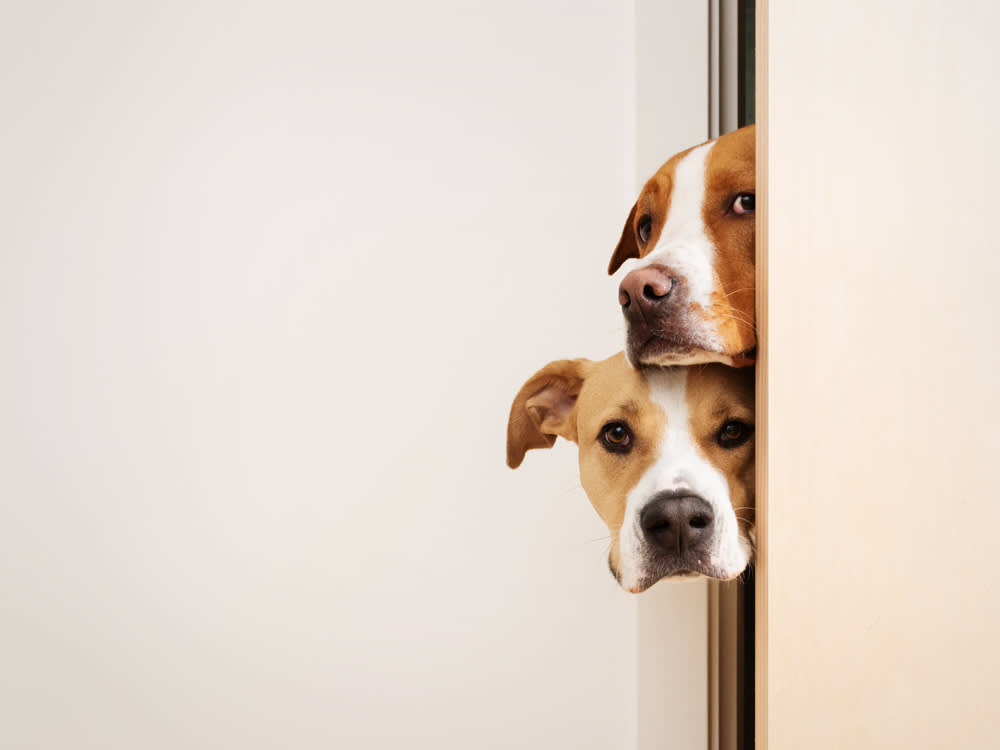Will My Skittish Dog Always Be Skittish?
Does your dog cower or startle easily?
Does your dog cower or startle easily?
by Kelly Villa, expert review by Mia Nguyen, CPDT-KA, FFCP | September 30, 2025

Alex / Adobe Stock
First, the good news: your skittish dog likely won’t stay skittish forever — but there are a few reasons why a dog might be jumpy or anxious to begin with. If your once fearless puppy suddenly becomes a skittish dog who startles easily, this skittishness is likely part of a normal developmental phase in dogs called a “fear period.” But there are other causes of skittishness, here’s what you need to know.
Socialization (or lack of it): Dogs who weren’t exposed to different people, places, sounds, and experiences between three and 16 weeks of age are more likely to grow up nervous or fearful.
Womb vibes are real: Yep, even before they’re born, puppies are affected by what their mom is going through. Stress hormones and other chemical signals in the womb can lead to lower birth weights, compromised immune systems, and shape how a dog responds to the world later.
Temporary fear periods: Puppies go through short, sensitive, fearful phases when they suddenly become more wary, even if they weren’t scared before. It’s normal, and usually temporary, but can have a lasting impact if something spooks them badly during this window or positive associations aren’t formed.
Past trauma or experiences: A history of abuse, neglect, or even one really scary event can leave lasting fear triggers in dogs. Even dogs who weren’t “abused” in the traditional sense can develop trauma from chronic stress, isolation, or being constantly overwhelmed.
Genetics: Just like people, every dog has their own temperament and personality — even pups from the same breed or litter can be wildly different. Some are simply more prone to anxiety or skittishness.
Fear periods are times during which young dogs are more likely to become scared by triggers that didn’t formerly bother them, like loud sounds outside or new people. Some signs your dog is fearful include body language such as crouching, lying down and freezing, panting, yawning, putting their ears back, and tucking their tail.
The first fear period happens around the time puppies leave their litter and are exposed to a new environment without the protection of their mother. The second generally happens when a dog is in adolescence (between six and fourteen months) and has been called “juvenile onset shyness” by behaviorist and dog trainer Patricia B. McConnell, PhD.

Turns out, adolescence isn’t just tough for humans—it can be hard on dogs, too.
These phases help teach young dogs how to be cautious and are just that: phases. So, if you suddenly find your dog cowering when they hear a loud car pass or running away from house guests, don’t panic. These periods generally last a few weeks and don’t have lasting effects of fearfulness as long as you can turn them into positive experiences.
Get them away from the trigger: When your dog is frightened by something, you should first and foremost remove them from the situation or allow them to move away, if that’s possible. This won’t reinforce their fear but will help build their trust in you.
Keep them calm by being calm: In addition (or if that’s not possible), you can also remain calm and talk in a relaxed, cheerful way to show your dog you’re not afraid.
Give your pet comfort: Providing comfort by petting them or giving them something they love, such as a treat, is also helpful; teaching them that good things can follow scary things will help them overcome their fear.
If your dog remains anxious and fearful for longer than a few weeks at these expected developmental phases or has always seemed overly skittish, they are likely dealing with deeper anxiety and will need more help overcoming their fearfulness. In this case, it’s important to recognize these signs as soon as possible — over time, fearful dogs act more intensely, become harder to distract, and can become destructive or reactive — and consult a veterinarian and/or animal behavior specialist.
“Developmental Stages - Canine Welfare Science.” Canine Welfare Science, 12 July 2023, caninewelfare.centers.purdue.edu/behavior/puppy-development/developmental-stages. Accessed 19 June 2025.
Sosnowski, David & Booth, Carolyn & York, Timothy & Amstadter, Ananda & Kliewer, Wendy. (2018). Maternal prenatal stress and infant DNA methylation: A systematic review. Developmental Psychobiology. 60. 10.1002/dev.21604.

Kelly Villa is a freelance writer and contributor to various pet publications.

Behavior & Training

Behavior & Training

Behavior & Training

Behavior & Training

Behavior & Training

Behavior & Training